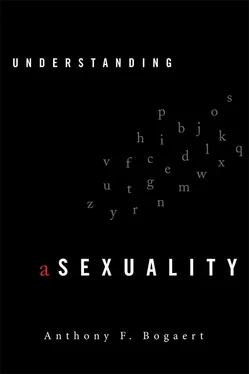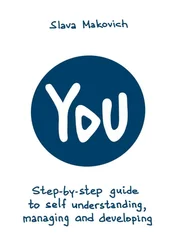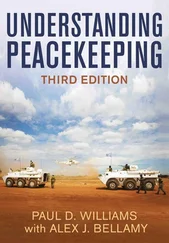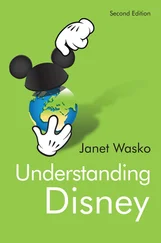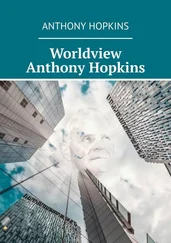Anthony F. Bogaert
UNDERSTANDING ASEXUALITY
A sincere thanks to the following people who helped at various stages of the development of this book: Carolyn Hafer, Sasha Noorgaard, Malvina Skorska, and the editorial staff at Rowman & Littlefield. Your support and generosity are greatly appreciated. I would also like acknowledge the love and support of my mother and father throughout the years; my academic career would not have been possible without them.
I teach and research human sexuality in two academic departments—the Department of Community Health Sciences and the Department of Psychology—at Brock University in the Niagara region of Canada. My university is supportive, and I expect that most of my university colleagues respect my work, but a few of my fellow professors are a bit dismissive of what I do. Some joke about what must go on in my human sexuality courses (e.g., “Your small-group seminars must be quite the party!” or “I bet there’s a lot of hands-on learning in your courses!”). Others tout my courses as the first to deserve a “little trimming” when university budgets are subject to cutbacks, the suggestion being that sex is taking up too much of the undergraduate curriculum, when, of course, more important and pithy matters could (and should!) supplant it. Still others question the utility of government grants being earmarked for the study of human sexuality.
Why do some of my colleagues treat my research and courses this way? I imagine that they do so, partly, out of a lingering notion that sexual activities, including teaching and research about sexual activities, have to do with the unseemly, the naughty, or at least the “unserious” side of life. I expect that the seed of this notion is sown very early in the lives of most Westerners (including in these few nonsupportive colleagues), germinates and reaches its peak during adolescence, and then persists in some form into adulthood. In fact, evidence of the persistence of this notion is charming, to a degree, when I witness my (usually male) colleagues revisit the raunchy side of their adolescence and engage in sex banter over a few beers.
I also imagine that these colleagues feel this way because they, like many of their fellow baby boomers, have slipped unawares into their current stage of life: middle age. (By the way, I have also reached this milestone, and have started to label it, somewhat bitterly, as the stage of “middle-aged ugly.” I call it so because, alas, our beauty—what little we may have had of it—has now faded, and we are saggy and increasingly hairless geeks. [1] I know that I am being an ageist to suggest that youth is synonymous with physical beauty. Well, to all you middle-aged people like me who think I am being ageist, all I have to say is this: Act your age! Attractiveness can be construed as the amount of draw or attention we can pull from others, and I think there are two age-sensitive, attention-getting components of attractiveness/beauty. First, there is a childlike “cuteness” component, which draws attention from others and is important because of its role in attaining the attention/care that children receive from competent others, such as parents. Thus, children have beauty in the form of “cuteness” that adults find appealing, because children need to draw adult attention to themselves in order to be cared for. As such, adults who retain some of this cuteness (e.g., boyish charm) can still draw their share of attention from others. The second youth-based component of beauty is related to fertility and reproductive vigor. Adolescents and adults need to draw the attention of others to reproduce, so it is not surprising that body and face features we find appealing are often cues to these characteristics. Furthermore, most people’s fertility and reproductive vigor (particularly that of women) peak in their twenties. So, alas, beauty is heavily youth based! We will discuss beauty and attractiveness in this book, as they also relate, obviously, to both sexuality and asexuality.
Cruel as it may be, fickle Hollywood, with its eyes fixed on beauty, has begun to give us the cold shoulder.) For some of my colleagues, with the best of their youthful charms and vigor behind them, sex is now increasingly off the radar, and a somewhat “de-sexualized” worldview holds sway. This reflects, of course, a natural transition most adults experience as middle-aged bodies start to change and preoccupations shift to other fancies, including, say, helping one’s children negotiate their lives. The famous psychoanalyst, Erik Erikson, aptly summarized this life stage as one preoccupied with generativity: the care of future generations (Stevens, 1983).
But some of my middle-aged colleagues’ newfound worldview has—yikes!—begun to undermine my work, as they have now started to give me looks and behave as if they have had an epiphany on academic values: Why should the study of sex matter so much, when for the vast majority of the moments in our lives, we are not engaged in it, and when the majority of our thoughts and preoccupations are not confined to this rather strange activity, even though, granted, they may have been years ago?
Well, maybe these colleagues are right. Why does sex matter so much? It is true that the vast majority of our lives, even during periods when our lives are extremely sexualized, is not spent engaging in sex. For example, in any given day, much more time is spent eating, watching TV, grooming, or sleeping than having sex. Indeed, sex does not even rate as an identifiable category when activities of the day are tallied (Longley, n.d.). Note that I am assuming a straightforward interpretation of these activities and not one more favorable to a turf-defending sexologist, who might argue that such tallies often do not take into account “hidden” time devoted to sex, such as viewing sexualized content on TV or other media, or “inner-life” activities such as sexual fantasizing. But no, let’s not quibble. It is true that sexual activities do not take much of the day at all, even if we include “hidden” sex time. So, what is all the fuss about?
In the 1970s, psychologists became more academically interested in human sexuality. This occurred for a number of reasons, not the least of which was that the sexual world opened up personally and scientifically in the wake of the 1960s sexual revolution. At that time, two publications by two social psychologists, Zick Rubin and Donn Byrne, put forward some convincing arguments that all the fuss about sex was in fact worth it, scientifically speaking (Rubin, 1973; Byrne, 1977). They catalogued a number of reasons for the importance of studying (and teaching about) sexuality. Here are some of their choice examples, [2] I thank the eminent sexologist, William Fisher, who introduced me to the articles by Rubin and Byrne, and who I believe mentioned some of these examples in one or more of his human sexuality lectures, which I attended as a graduate student.
along with a few of my own.
Sex is intrinsically interesting to most people, even to those who are not in the reproductive prime of their lives. That my middle-aged colleagues often still turn to the subject of sex after a few beers is evidence that they are still interested in sex, even if their daily lives may contain little behavior that is actually sexual. The prevalence of sexual allusions, if not outright sexual content, in the media also attests to the fact that sex is capable of arousing curiosity in, along with titillating, the young and old alike. In 2010, the most “Googled” person was not the president of the United States or the pope, but Lady Gaga, the pop music star with a hyper-sexed persona.
Читать дальше
